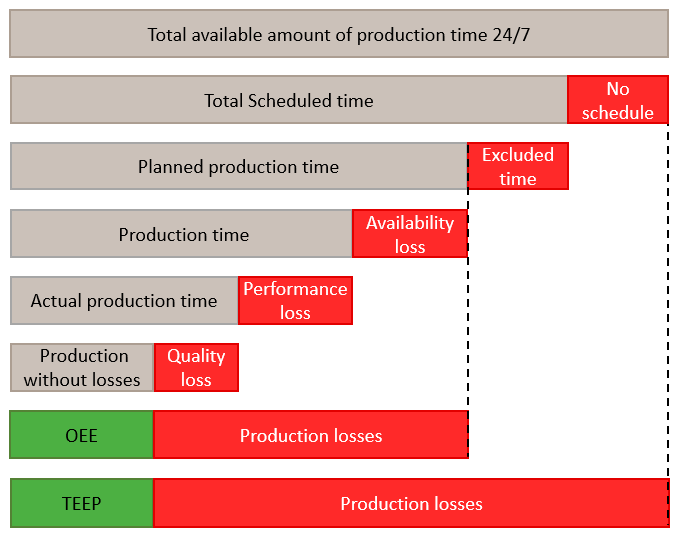Time model for OEE
To determine OEE, start with the time available for the machine, which is "24/7", i.e., 24 hours every day, seven days a week.
First, subtract the time the machine is not planned to be in use. This is usually equivalent to when the factory is closed, and no production can be done. This calculation gives your Total Scheduled Time.
Next, deduct the time the machine is not manned to be in use. The remaining time, Manned Machine Time or Planned Production Time, is the baseline from which OEE is calculated.
Time excluded from Planned Production Time can, for example, be the consequence of lack of orders.
It's often tempting to exclude other stop time such as breaks, meetings, and more as this would indicate a higher OEE value. Please don't fall into this trap, rather focus on why you are using OEE as a KPI. What's more important; to report a number or to identify the hidden potential in your factory? If it is the latter, we recommend that you include as many losses as possible.
All losses from Planned Production Time are included in either Availability losses, Performance losses or Quality losses.
Availability
Availability or Uptime is all Planned Production Time minus all Availability losses. Availability losses are all types of stops in the production process that are long enough not to be considered a delayed cycle.
To work efficiently with disturbance management, identify the reasons behind the stop and give it a reason code. Stops that are so short that it is not reasonable or relevant to assign a reason code are "Micro stops".
Modern OEE systems label Micro stops for what they are – availability losses. When calculating OEE manually, Micro stops are usually the result of the time that is not accounted for and can be difficult to separate from speed loss.
Performance
Performance describes if the machine has been running at optimal speed during the Uptime. All performance losses cause the machine to produce at a lower speed than optimal and classified as "speed losses". Reasons for speed losses can be issues with material, understaffed machine, worn-out machine parts, or merely a wrong setting. Time remaining when deducting Speed Losses is Net Production Time.
Quality
Quality measures the level of approved items that comes out from the production process, including rework. Rework is when the item has to go through the process multiple times. Time remaining when deducting Quality Losses is Value Adding Time.
